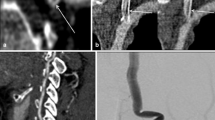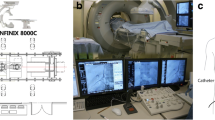Abstract
Objectives
To bring out the role of multi-slice spiral CT angiography (MS-CTA) in patient management after endovascular therapy of subclavian artery stenosis.
Methods
Twenty-one consecutive patients with clinically suspected restenosis after endovascular treatment of subclavian artery stenosis or occlusion were included in the study. Eleven patients had been treated with percutaneous transluminal angioplasty (PTA) alone and 10 with PTA and stenting. The mean follow-up period after PTA or stenting was 57 (±27 SD) months. CTA was performed using a bolus-triggered high-resolution protocol with biphasic intravenous contrast medium injection. Axial images and curved planar reformations (CPRs) were rated by three readers with regard to patency of supra-aortic vessels. Imaging findings were correlated with a standardized clinical assessment.
Results
All examinations were of diagnostic quality. Of 21 referred patients, 7 had significant reobstruction of the treated subclavian artery. Six of the 7 patients with significant restenosis on CTA were treated conservatively (antiplatelet agents), despite 2 of them being symptomatic on the standardized clinical assessment, which showed a sensitivity and specificity of 86% in predicting stenosis. One patient was treated with PTA and stent deployment because of strong subjective suffering.
Conclusion
MS-CTA is useful for exclusion or quantification of clinically suspected restenosis in carefully selected patients after endovascular therapy where ultrasound is inconclusive and/or contrast-enhanced magnetic resonance angiography is contraindicated.

Similar content being viewed by others
References
de la Garza O, Lierse W, Steiner D (1992) Anatomical study of the blood supply in the human shoulder region. Acta Anat 145:412–415
English JA, Carell ES, Guidera SA, et al. (2001) Angiographic prevalence and clinical predictors of left subclavian stenosis in patients undergoing diagnostic cardiac catheterization. Catheter Cardiovasc Interv 54:8–11
Gutierrez GR, Mahrer P, Aharonian V, et al. (2001) Prevalence of subclavian artery stenosis in patients with peripheral vascular disease. Angiology 52:189–194
Shadman R, Criqui MH, Bundens WP, et al. (2004) Subclavian artery stenosis: Prevalence, risk factors, and association with cardiovascular diseases. J Am Coll Cardiol 44:618–623
Hausegger KA, Tiesenhausen K, Schedlbauer P, et al. (2001) Treatment of acute aortic type B dissection with stent-grafts. Cardiovasc Intervent Radiol 24:306–312
Stone JA, Mukherji SK, Semelka R, et al. (2000) Contrast-enhanced 3D FISP MR angiography of the aortic arch ostia: Preliminary results. J Comput Assist Tomogr 24:369–374
Neimatallah MA, Chenevert TL, Carlos RC, et al. (2000) Subclavian MR arteriography: Reduction of susceptibility artifact with short echo time and dilute gadopentetate dimeglumine. Radiology 217:581–586
Kumar S, Roy S, Radhakrishnan S, et al. (1996) Three-dimensional time-of-flight MR angiography of the arch of aorta and its major branches: a comparative study with contrast angiography. Clin Radiol 51:18–21
Hudak PL, Amadio PC, Bombardier C (1996) Development of an upper extremity outcome measure: the DASH (disabilities of the arm, shoulder and hand) [corrected] The Upper Extremity Collaborative Group (UECG). Am J Ind Med 29:602–608
Offenbaecher M, Ewert T, Sangha O, et al. (2002) Validation of a German version of the disabilities of arm, shoulder, and hand questionnaire (DASH-G). J Rheumatol 29:401–402
Kirchner J, Kickuth R, Laufer U, et al. (2000) Optimized enhancement in helical CT: Experiences with a real-time bolus tracking system in 628 patients. Clin Radiol 55:368–373
Fleischmann D, Hittmair K (1999) Mathematical analysis of arterial enhancement and optimization of bolus geometry for CT angiography using the discrete Fourier transform. J Comput Assist Tomogr 23:474–484
Fleischmann D, Rubin GD, Bankier AA, et al. (2000) Improved uniformity of aortic enhancement with customized contrast medium injection protocols at CT angiography. Radiology 214:363–371
Hittmair K, Fleischmann D (2001) Accuracy of predicting and controlling time-dependent aortic enhancement from a test bolus injection. J Comput Assist Tomogr 25:287–294
Gies M, Kalender WA, Wolf H, et al. (1999) Dose reduction in CT by anatomically adapted tube current modulation. I. Simulation studies. Med Phys 26:2235–2247
Greess H, Wolf H, Baum U, et al. (2000) Dose reduction in computed tomography by attenuation-based on-line modulation of tube current: evaluation of six anatomical regions. Eur Radiol 10:391–394
Prokesch RW, Coulam CH, Chow LC, et al. (2002) CT Angiography of the subclavian artery: Utility of curved planar reformations. J Comput Assist Tomogr 26:199–201
Mastora I, Remy-Jardin M, Delannoy V, et al. (2004) Multi-detector row spiral CT angiography of the thoracic outlet: Dose reduction with anatomically adapted online tube current modulation and preset dose savings. Radiology 230:116–124
Ghaye B, Szapiro D, Mastora I, et al. (2001) Peripheral pulmonary arteries: How far in the lung does multi-detector row spiral CT allow analysis? Radiology 219:629–636
Dorffner R, Thurnher S, Prokesch R, et al. (1998) Spiral CT during selective accessory renal artery angiography: Assessment of vascular territory before aortic stent-grafting. Cardiovasc Intervent Radiol 21:179–182
Raza SA, Chughtai AR, Wahba M, et al. (2004) Multislice CT angiography in renal artery stent evaluation: Prospective comparison with intra-arterial digital subtraction angiography. Cardiovasc Intervent Radiol 27:9–15
Livstone BJ, Parker L, Levin DC (2002) Trends in the utilization of MR angiography and body MR imaging in the US Medicare population: 1993–1998. Radiology 222:615–618
Maitino AJ, Levin DC, Parker L, et al. (2003) Nationwide trends in rates of utilization of noninvasive diagnostic imaging among the Medicare population between 1993 and 1999. Radiology 227:113–117
Maintz D, Kugel H, Schellhammer F, et al. (2001) In vitro evaluation of intravascular stent artifacts in three-dimensional MR angiography. Invest Radiol 36:218–224
Mastora I, Remy-Jardin M, Suess C, et al. (2001) Dose reduction in spiral CT angiography of thoracic outlet syndrome by anatomically adapted tube current modulation. Eur Radiol 11:590–596
Liu Y, Hopper KD, Mauger DT, et al. (2000) CT angiographic measurement of the carotid artery: Optimizing visualization by manipulating window and level settings and contrast material attenuation. Radiology 217:494–500
Claves JL, Wise SW, Hopper KD, et al. (1997) Evaluation of contrast densities in the diagnosis of carotid stenosis by CT angiography. AJR Am J Roentgenol 169:569–573
Macari M, Israel GM, Berman P, et al. (2001) Infrarenal abdominal aortic aneurysms at multi-detector row CT angiography: Intravascular enhancement without a timing acquisition. Radiology 220:519–523
Bae KT, Tran HQ, Heiken JP (2000) Multiphasic injection method for uniform prolonged vascular enhancement at CT angiography: Pharmacokinetic analysis and experimental porcine model. Radiology 216:872–880
Fleischmann (2003) Use of high concentration contrast media: Principles and rationale-vascular district. Eur J Radiol 45(Suppl 1):S88–93
Bader TR, Prokesch RW, Grabenwoger F (2000) Timing of the hepatic arterial phase during contrast-enhanced computed tomography of the liver: Assessment of normal values in 25 volunteers. Invest Radiol 35:486–492
Reiner BI, Siegel EL, Hooper FJ (2002) Accuracy of interpretation of CT scans: Comparing PACS monitor displays and hard-copy images. AJR Am J Roentgenol 179:1407–1410
Osborn LA, Vernon SM, Reynolds B, et al. (2002) Screening for subclavian artery stenosis in patients who are candidates for coronary bypass surgery. Catheter Cardiovasc Interv 56:162–165
Shadman R, Criqui MH, Bundens WP, et al. (2004) Subclavian artery stenosis: Prevalence, risk factors, and association with cardiovascular diseases. J Am Coll Cardiol 44:618–623
Schillinger M, Haumer M, Schillinger S, et al. (2001) Risk stratification for subclavian artery angioplasty: Is there an increased rate of restenosis after stent implantation? J Endovasc Ther 8:550–557
Schillinger M, Haumer M, Schillinger S, et al. (2002) Outcome of conservative versus interventional treatment of subclavian artery stenosis. J Endovasc Ther 9:139–146
Acknowledgment
This research was partly supported by the Austrian Science Fund (FWF) under the grant P17083-N04.
Author information
Authors and Affiliations
Corresponding author
Rights and permissions
About this article
Cite this article
Peloschek, P., Sailer, J., Loewe, C. et al. The Role of Multi-slice Spiral CT Angiography in Patient Management After Endovascular Therapy. Cardiovasc Intervent Radiol 29, 756–761 (2006). https://doi.org/10.1007/s00270-004-0066-9
Published:
Issue Date:
DOI: https://doi.org/10.1007/s00270-004-0066-9




